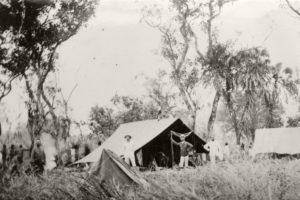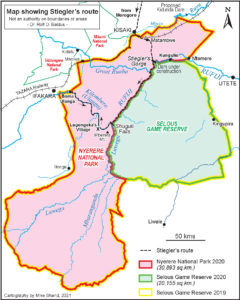by Rolf D. Baldus
A Gorge in Africa’s oldest and largest protected Area
The Tanzanian Government is building a large hydroelectric dam at a place called “Stiegler’s Gorge” in Southern Tanzania, where the mighty Rufiji river thunders through a narrow 100m deep gorge and over several kilometres of rapids. To the north is the newly proclaimed Nyerere National Park, while to the south lies the famous Selous Game Reserve, declared a UNESCO World Heritage Site in 1982 – a status that may be imperilled by the hydropower project. The man after whom the gorge was named – “Stiegler” – remained a mystery until recently.
Franz Stiegler goes to Africa
It was generally assumed that Stiegler had been a Swiss engineer who, at the beginning of the last century, examined the possibilities of constructing a bridge or a dam across the gorge and that he was killed by an elephant while hunting close to the gorge. Information from relatives of the man and some further research, however, has now shed light on this mysterious person and the events leading to his death.
Franz Stiegler was born in a village called Dießen on the Ammersee in Southern Germany around 1878. He became a civil engineer and emigrated to German East Africa in 1905 or in early 1906.
In 1905 the German colonial Government had started to construct the “Tanganyika Railway” (Central Line), which was to connect Dar es Salaam with Lake Tanganyika. Young Stiegler was employed as a surveyor starting in February 1907.
Later in that year he became the leader of the Rufiji Expedition. In July 1907 he camped at the Pangani Rapids on the Rufiji River – the place which now bears his name. On July 13th, 1907 he wrote in a card to his sister that a lion had attacked the camp and severely injured one of his African staff. Notwithstanding, he concludes: “It is a very nice trip.”
The expedition was to explore the river and the surrounding lands, conduct trigonometric and hydrological surveys, in particular take measurements of water flow and water levels. The colonial administration wanted to appraise the navigability of the Rufiji and the Kilombero (Ulanga) rivers. The viability of connecting Boma Ulanga (southern Kilombero Valley) by railway with the Central Line and with the lower Rufiji was another question.
On December 12th 1907 Stiegler camped at the Shuguli Falls, a very scenic spot where the Kilombero flows over a kilometre or so through a myriad of falls, ponds and ravines. He writes from there to his sister that he will continue from the falls up the Kilombero River to Boma Ulanga. Then he would unfortunately have to return to work on the railway again.
Stiegler was assisted by several local employees and at times by the German survey technician R. Pelz, who will later write in an obituary that Stiegler was “an example of a distinguished and fair-minded superior.”
Franz Stiegler came from a family of hunters, and he used the opportunities that the game-rich land offered, to hunt, not least to feed his party. He bought hunting licences, as his name can be found in the lists of licence-holders which were published every year in Official Gazette for German East Africa.
A deadly encounter with an elephant
On February 17, 1908, Stiegler camped 8 km away from Mberera Mountain. He was most probably on the way back to Morogoro. His local companions narrated later that he went hunting and wounded an elephant. The Deutsch Ostafrikanische Zeitung of April 11, 1908, gives this account: “The elephant … immediately attacked and flung a black man aside. Stiegler also jumped aside, but probably not fast enough, for he was seized by the elephant and hurled into the air. Death was instantaneous.” The body was taken to “Lugongeka’s village” the next morning and buried there. This village can be found on a German map of the time. From Shuguli it is 20 km up the Kilombero river on the south bank.
The place where Franz Stiegler met his fate is about 100 km direct distance south-west and upriver of the gorge which was later named after him.
The German and later the British colonial Governments continued to call the place Pangani Rapids. We find the term Stiegler’s Gorge first mentioned in the 1950´s. A tourist map of around 1970 uses the term too in connection with a lodge that seems to have existed on the high ground over the rapids. It remains a mystery who named the Gorge after Franz Stiegler and when.
The author wishes to acknowledge the contribution of Günter Kraus, a relative of Franz Stiegler, who provided indispensable information and to Mike Shand (University of Glasgow) for his assistance with the mapping.
Bibliography:
Baldus, Rolf D. (Ed.): Wild Heart of Africa. The Selous Game Reserve in Tanzania. Johannesburg 2009.
Baldus, Rolf D. (2021) The End of the Game, in: Sports Afield, No.1 and http://www.wildlife-baldus.com/selous_game.html


